Author: Kairos Research, Translation: Jinse Finance xiaozou
1, Introduction
Today, EigenDA is the largest re-staking capital and unique address AVS (Active Verification Service) operator, with more than 3.64 million re-staking ETH and 70 million re-staking EIGEN from 245 operators and 127,000 unique address staking wallets, totaling about $9.1 billion in re-staking capital. With the launch of a large number of alternative data availability (DA) platforms, it is difficult to decipher the differences between them, their unique value propositions, and how the accumulation of protocol value changes. In this article, we will take a deep dive into EigenDA and explore the unique mechanisms of its design, while also taking an overview of the competitive landscape and analyzing potential developments in this market space.
2、Understand DA (Data Availability)
Before we dive into EigenDA, let's first take a look at the concept of data availability (DA) and its importance. Data availability refers to ensuring that all participants (nodes) in the network have access to all the necessary data needed to verify transactions and maintain the blockchain. DA is part of the typical monolithic architecture, and we have seen many people write a lot about this - but in short, execution, consensus, and settlement all rely on DA. Without DA, the integrity of the blockchain will be fundamentally compromised.
The dependence of all other parts of the blockchain on DA creates a scaling bottleneck, which is why the L2 roadmap appears in front of us. With the introduction of Optimistic rollup in 2019, the L2 future was born. L2 execution is performed off-chain, but still relies on Ethereum's DA to maintain Ethereum's security guarantees. With this paradigm shift, many people realize that the advantages of L2 may be further strengthened by building specific blockchains or focusing on various services that improve the limitations of the monolithic architecture DA layer.
While the emergence of a specific DA layer provides a realistic opportunity to reduce fees through competition and further experiments, the DA problem is being solved on the Ethereum mainnet through a process called "Dank Sharding". The first part of Dank Sharding is implemented through EIP-4844, which introduces transactions that carry additional data blobs, up to 125 KB, which are submitted using KZG (a cryptographic commitment) to ensure data integrity and future compatibility with data availability sampling. Prior to the implementation of EIP-4844, rollups were published to Ethereum using calldata to publish rollup transaction data.
Since the Dancun upgrade went live with the danksharding prototype in mid-March, 2.4 million blobs (total data size of 294 G) have paid L1 more than 1,700 ETH. It is important to note that the EVM cannot access the blob data and the blob data is automatically deleted after about 2 months. Currently there is a limit of 6 blobs per block, totaling 750KB. If you are a non-technical reader, you need to know that if you hit the blobspace cap for three consecutive blocks, you will end up with the equivalent of a normal Gamecube memory card.
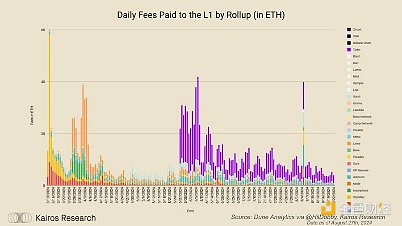
This limit is indeed hit multiple times a day, indicating that demand for Ethereum blobspace is high. While the Ethereum blob base fee is around $5 at the time of writing, we should be careful to note that this fee fluctuates with the price of ETH, as does most DeFi activity. Therefore, when the price of ETH is rising, there will be more activity, which in turn will lead to more demand for blobspace. Therefore, in order to be ready for more DeFi speculation, or to open up the network to meet unseen use cases, the costs of data availability must be further reduced. There is still ample incentive to further reduce these costs to encourage continued active user activity.
3、How EigenDA works
EigenDA is based on a simple principle, that is, data availability does not require independent consensus to solve, so EigenDA is designed to be linearly scalable in structure, and the main role of operators is to handle data storage. The EigenDA architecture has three main parts:
● Operators
● Disperser
● Retreivers
EigenDA's Operators are the parties or entities responsible for running the EigenDA node software. They register EigenLayer and obtain staking authorization. You can think of them as node operators in traditional proof-of-stake networks. However, the role of these operators is to store blobs associated with valid storage requests without assuming consensus responsibility. In this specific instance, a valid storage request is one where the fee is paid and the provided blob block is validated against the provided KZG commitment and proof.
In short, KZG commitments allow you to link a block of data with a unique code (the commitment) and then prove that a given block of data is the original data using a special key (the proof). This ensures that the data has not been altered or tampered with, thus maintaining the integrity of the blob.
Disperser is referred to as an "untrusted" service in the EigenenDA documentation and is hosted by EigenLabs. Its main responsibility is to interface between EigenDA clients, operators, and contracts. EigenDA clients make dissemination requests to the dispenser, which Reed-Solomon encodes the data to help with data recovery, then computes the KZG commitment for the encoded blob and generates a KZG proof for each block of data. After that, the disperser sends these data blocks, KZG commitments, and KZG proofs to the EigenDA operator, who then returns the signatures. The disperser finally aggregates these signatures and uploads them to Ethereum in the form of calldata. It should be noted that this step is a necessary prerequisite for sacking operators who misbehave.
The last core component of EigenDA, Retriver, is a service that requests blob blocks from the EigenDA operator, verifies that the blob blocks are accurate, and then reconstructs the original blob for the user. EigenDA can host the retriever service, and client rollups can also host their own retrievers as sidecars for their sorters.
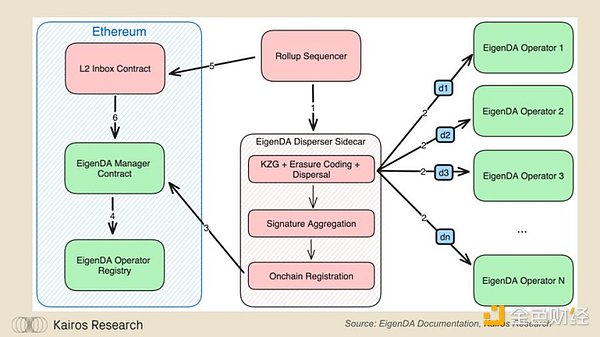
Here is how EigenDA actually works:
● The Rollup sorter sends a batch of transactions as a blob to EigenDA’s disperser sidecar.
● EigenDA disperser sidecar erasure encodes the blob into data blocks, generates a KZG commitment and multi-reveal proof for each block, and sends the data block to the EigenDA operator to receive the storage proof signature.
● After aggregating the received signatures, the disperser registers the blob on-chain by sending a transaction to the EigenDA Manager contract with the aggregated signature and blob metadata.
● The EigenDA Manager contract verifies the aggregate signature with the help of the EigenDA Registry contract and stores the result on-chain.
● Once the blob is stored off-chain and registered on-chain, the sorter publishes the EigenDA blob ID to its inbox contract in the transaction. The blob ID length does not exceed 100 bytes.
● Before receiving the blob ID into the rollup inbox, the inbox contract asks the EigenDA Manager contract whether the blob is authorized for use. If so, the blob ID is allowed to enter the inbox contract. Otherwise, the blob ID will be deprecated.
In short, the sorter sends the data to EigenDA, which splits the data into blocks, stores it, and checks whether the data is safe. If everything looks OK, the data will be green-lit to move forward. If not, the data will be discarded.
4、Competitive Landscape
From a broader perspective on the competitive landscape of DA services, EigenDA has a clear advantage over other services in terms of throughput. As more operators join the network, the opportunity to expand potential throughput is also increasing. In addition, when considering which other DA service is most "consistent with Ethereum", it is not difficult to see that EigenDA is the clear choice.
While Celestia has groundbreaking innovations in DAS, it is difficult to regard it as completely consistent with ETH. It is not mandatory, but it will definitely have an impact on the client's decision on which service to use. Celestia also implements an interesting strategy in its light node architecture to support larger blocks, so more potential blobs can be included, but subject to certain restrictions.
As it stands, Celestia has successfully reduced the operational costs of rollups and passed them on to end users. However, despite being a meaningful and impactful innovation, there has been little actual traction in terms of fee accumulation, despite a fully diluted valuation in the billions of dollars (~$5.5 billion at the time of writing). Celestia launched last Halloween, and since then, 20 rollups have integrated their DA service. These 20 rollups have published a total of 54.94 GB of blobspace data, supporting the protocol to collect 4,091 TIAs, worth about $21,000 at current prices. However, the accumulated fees are paid to stakeholders and validators, which is fair, and the price of TIAs has changed over time, reaching an all-time high of 19.87, so the actual amount may vary. Using secondary data, we can estimate that the total fees in USD are more likely to be around $35,000.
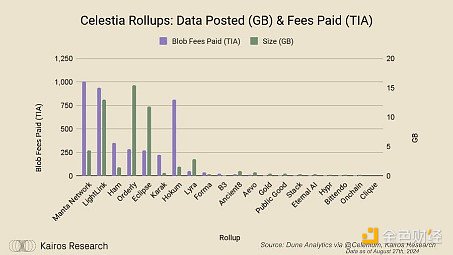
5、RollupCurrent Landscape and EigenDA Positioning
EigenDA pricing was recently announced, and it has an "on-demand" option, as well as three different tiers. The on-demand option provides a variable throughput of 0.015 ETH/GB, and "tier 1" is 256 KiB/s at a price of 70 ETH. Looking at the current DA situation on the Ethereum mainnet, we can make some speculations about the potential demand for EigenDA and how much revenue this may bring to investors.
For now, there are about 27 rollups that use query data to publish blob data to Ethereum L1. After EIP-4844 was deployed, each blob published to Ethereum had 128kb of data. Across these 27 rollups, approximately 2.4 million blobs were published, totaling 295 GB of data. So if all of these rollups were priced at 0.015 ETH/GB, that would be 4.425 ETH.
At first glance, this seems a bit problematic. However, it is important to note that rollups vary widely in terms of unique product offerings and architectures. Due to design differences and different user bases, the amount of blobs published and the fees paid to L1 vary greatly. For example, for the rollups in this article, we are referring to the amount of blobs (GB) and fees used by each rollup.
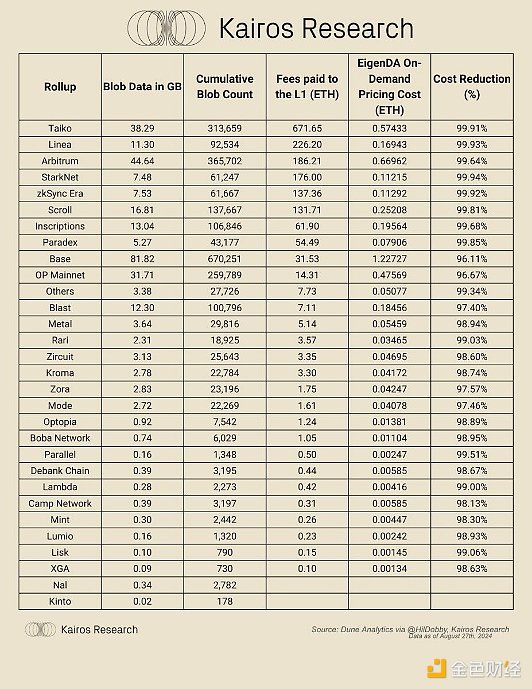
From this analysis alone, 6 rollups have crossed the relevant fee threshold, giving them a reason to choose EigenDA's tier 1 pricing, but it does not seem to make sense for them in terms of pure data throughput. In fact, using EigenDA's on-demand pricing can still reduce direct costs by about 98.91% on average.
Therefore, this puts re-stakers and other ecosystem stakeholders in a dilemma. The cost reduction brought by EigenDA is good for both L2 and their users, as it will bring more profits and revenue to L2, but this has not discouraged re-stakers who hope that EigenDA will become the AVS with the highest re-staking rewards.
However, another explanation is that EigenDA's cost reduction stimulates innovation. Throughout history, we have seen numerous examples of cost reduction being a key growth catalyst. For example, the Bessam steelmaking process in the history of steel was an innovation that significantly reduced the cost and time of steel production, enabling mass production of stronger, higher quality steel at an 82% cost reduction. One could argue that similar principles apply to DA services, and that the introduction of multiple DA service providers not only significantly reduced costs (enforced by competition), but also inherently spurred innovation, allowing more high-throughput rollups to be released, pushing the boundaries of design that were previously unexplored.
For example, Eclipse, an SVM rollup that just started releasing blobs 28 days ago, already accounts for 86% of all blobs on Celestia. Their mainnet isn’t even open to the public yet, and while it’s likely that much of this use is purely for testing purposes to ensure the reliability of the technology, it gives us a glimpse into what’s possible with high-throughput rollups, and allows us to see that they will consume more DA than most rollups we see today.
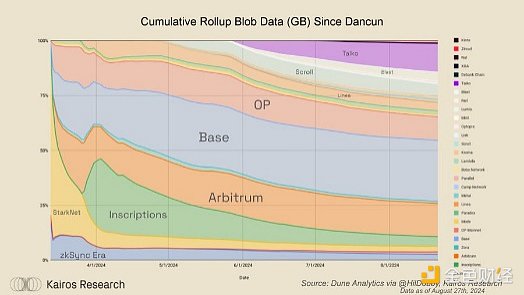
6, Conclusion
So where does this leave us? In order to reach the $160,000 monthly revenue target set by the EigenDA team in the blog post, choosing tier 1 pricing of 70 ETH per year, assuming an average ETH price of about $2,500, you would need to have 11 paid rollups. In our analysis, we see that since EIP-4844 went live in early March, there have been about 6 rollups with fees exceeding 70 ETH paid to L1 alone. As we said earlier, on-demand pricing would still reduce the cost of all of these rollups by about 99%, but ultimately the throughput they expect will be the deciding factor in whether they choose to use EigenDA.
Beyond this, we will likely see demand driven by the creation of multiple high-throughput rollups like MegaETH to drive down costs. In the future, it is also possible that these types of high-performance rollups will be deployed through Rollup-as-a-Service (RaaS) providers like AltLayer and Conduit. However, in the short term, it will take some proof of work to reach the $160,000 monthly revenue target, assuming only break-even with just 400 operators backing EigenDA. Overall, EigenDA opens up the possibility of new designs that could have very high added value, but it is not entirely clear how much value EigenDA will capture and how much will be given back to re-stakers. Nonetheless, we continue to believe that EigenDA has the ability to capture a large portion of the DA market share as a DA provider, and we will continue to keep an eye on one of the most prominent AVS.
 JinseFinance
JinseFinance
 JinseFinance
JinseFinance XingChi
XingChi JinseFinance
JinseFinance JinseFinance
JinseFinance Coinlive
Coinlive  Finbold
Finbold Bitcoinist
Bitcoinist Bitcoinist
Bitcoinist Cointelegraph
Cointelegraph Cointelegraph
Cointelegraph